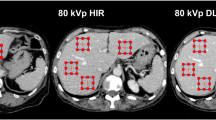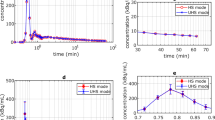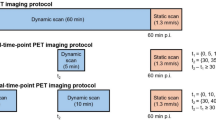Abstract
Purpose
The purpose of this study was to evaluate the effect of defective positron emission tomography (PET) detectors on clinical PET image quality in simultaneous PET/magnetic resonance imaging (MRI) for both time-of-flight (TOF) and non-TOF reconstructed images.
Procedures
A total of six patients with various malignant tumors were included and underwent a 2-deoxy-2-[18F]fluoro-d-glucose PET scan in a fully functional simultaneous TOF PET/MRI. TOF and non-TOF PET images were reconstructed before and after simulating defective detector units. All images were clinically assessed and scored. In addition, a quantitative assessment was performed. Differences were ascertained and compared using the Wilcoxon matched pairs signed-rank test.
Results
Without TOF, the image artifacts introduced by one defective detector unit already started to degrade the overall image quality. It reduced the confidence and could lead to a change in diagnosis. Simulating three or five defective detector units resulted in more artifacts and further reduced overall image quality and confidence. By including TOF information, the effects were mitigated: Images reconstructed with one defective detector unit had similar scores as the ones without defective units. The average absolute percentage error for one, three, and five defective detector units were respectively 8, 20, and 37 % for the non-TOF cases and only 5, 11, and 19 % for the TOF cases.
Conclusion
Our study indicates that PET image artifacts due to (simulated) defective detectors are significantly mitigated with the integration of TOF information in simultaneous PET/MR. One defective detector unit introduces, on average, a 5 % absolute percentage error. However, in TOF imaging, even in cases with one or three defective units for head and neck imaging and one defective unit for chest and abdominal imaging, overall image quality, artifact scoring, and reader confidence are not significantly degraded.







Similar content being viewed by others
References
Buchert R, Bohuslavizki KH, Mester J, Clausen M (1999) Quality assurance in PET: evaluation of the clinical relevance of detector defects. J. Nucl. Med. 40:1657–1665
Elhami E, Samiee M, Demeter S et al (2011) On the significance of defective block detectors in clinical 18F-FDG PET/CT imaging. Mol. Imaging Biol. 13:265–274
Zito F, De Bernardi E, Schiavini M et al (2007) Analysis of different detector and electronics defects on F18-FDG images. Nucl. Instrum. Methods Phys. Res., Sect. A 571:493–497
Boellaard R, Quick HH (2015) Current image acquisition options in PET/MR. Semin. Nucl. Med. 45:192–200
Delso G, Ter Voert E, Veit-Haibach P (2015) How does PET/MR work? Basic physics for physicians. Abdom. Imaging 40:1352–1357
Delso G, Fürst S, Jakoby B et al (2011) Performance measurements of the Siemens mMR integrated whole-body PET/MR scanner. J. Nucl. Med. 52:1914–1922
Zaidi H, Del Guerra A (2011) An outlook on future design of hybrid PET/MRI systems. Med. Phys. 38:5667–5689
Levin C, Glover G, Deller T et al (2013) Prototype time-of-flight PET ring integrated with a 3 T MRI system for simultaneous whole-body PET/MR imaging. J Nucl Med Meeting Abstracts 54:148
Haemisch Y, Frach T, Degenhardt C, Thon A (2012) Fully digital arrays of silicon photomultipliers (dSiPM)—a scalable alternative to vacuum photomultiplier tubes (PMT). Phys. Procedia 37:1546–1560
Moses WW (2003) Time of flight in PET revisited. Nuclear Science, IEEE Transactions on 50:1325–1330
Moses WW (2007) Recent advances and future advances in time-of-flight PET. Nucl Instrum Methods Phys Res A 580:919–924
Surti S (2015) Update on time-of-flight PET imaging. J. Nucl. Med. 56:98–105
Karp JS, Surti S, Daube-Witherspoon ME, Muehllehner G (2008) Benefit of time-of-flight in PET: experimental and clinical results. J. Nucl. Med. 49:462–470
Surti S, Kuhn A, Werner ME et al (2007) Performance of Philips Gemini TF PET/CT scanner with special consideration for its time-of-flight imaging capabilities. J. Nucl. Med. 48:471–480
Daube-Witherspoon ME, Surti S, Perkins AE, Karp JS (2014) Determination of accuracy and precision of lesion uptake measurements in human subjects with time-of-flight PET. J. Nucl. Med. 55:602–607
El Fakhri G, Surti S, Trott CM et al (2011) Improvement in lesion detection with whole-body oncologic time-of-flight PET. J. Nucl. Med. 52:347–353
Surti S, Karp JS (2009) Experimental evaluation of a simple lesion detection task with time-of-flight PET. Phys. Med. Biol. 54:373–384
Conti M (2011) Why is TOF PET reconstruction a more robust method in the presence of inconsistent data? Phys. Med. Biol. 56:155–168
Boellaard R, Hofman MB, Hoekstra OS, Lammertsma AA (2014) Accurate PET/MR quantification using time of flight MLAA image reconstruction. Mol. Imaging Biol. 16:469–477
Davison H, ter Voert EE, de Galiza BF, Veit-Haibach P, Delso G (2015) Incorporation of time-of-flight information reduces metal artifacts in simultaneous positron emission tomography/magnetic resonance imaging: a simulation study. Investig. Radiol. 50:423–429
Mehranian A, Zaidi H (2015) Impact of time-of-flight PET on quantification errors in MR imaging-based attenuation correction. J. Nucl. Med. 56:635–641
Rua Q, Manjeshwar RM, Ambwani S, Wollenweber SD (2012) Truncation completion of MR-based PET attenuation maps using time-of-flight non-attenuation-corrected PET images [abstract]. 2773-2775P.
ter Voert E, Delso G, Ahn S, et al. (2014) The effect of TOF on PET reconstructions in patients with (metal) implants in simultaneous TOF PET/MR scanning [abstract]. SSK18-06P.
Turkington TG, Wilson JM (2009) Attenuation artifacts and time-of-flight PET [abstract]. 2997-2999P.
de Galiza Barbosa F, Delso G, Zeimpekis KG, et al. (2015) Evaluation and clinical quantification of neoplastic lesions and physiological structures in TOF-PET/MRI and non-TOF/MRI—a pilot study. Q J Nucl Med Mol Imaging.
Vontobel J, Liga R, Possner M et al (2015) MR-based attenuation correction for cardiac FDG PET on a hybrid PET/MRI scanner: comparison with standard CT attenuation correction. Eur. J. Nucl. Med. Mol. Imaging 42:1574–1580
Delso G, Khalighi M, Ter Voert E et al (2016) Effect of time-of-flight information on PET/MR reconstruction artifacts: comparison of free-breathing versus breath-hold MR-based attenuation correction. Radiology:152509
Surti S, Karp JS (2008) Design considerations for a limited angle, dedicated breast, TOF PET scanner. Phys. Med. Biol. 53:2911–2921
Nguyen NC, Vercher-Conejero JL, Sattar A et al (2015) Image quality and diagnostic performance of a digital PET prototype in patients with oncologic diseases: initial experience and comparison with analog PET. J. Nucl. Med. 56:1378–1385
Wollenweber SD, Ambwani S, Lonn AHR et al (2013) Comparison of 4-class and continuous fat/water methods for whole-body, MR-based PET attenuation correction. IEEE Trans. Nucl. Sci. 60:3391–3398
Wollenweber SD, Ambwani S, Delso G et al (2013) Evaluation of an atlas-based PET head attenuation correction using PET/CT & MR patient data. IEEE Trans. Nucl. Sci. 60:3383–3390
Surti S, Karp JS, Popescu LM, Daube-Witherspoon ME, Werner M (2006) Investigation of time-of-flight benefit for fully 3-D PET. IEEE Trans. Med. Imaging 25:529–538
Author information
Authors and Affiliations
Corresponding author
Ethics declarations
Ethical Approval
All procedures performed in studies involving human participants were in accordance with the ethical standards of the institutional and/or national research committee and with the 1964 Helsinki Declaration and its later amendments or comparable ethical standards.
Informed Consent
Informed consent was obtained from all individual participants included in the study.
Conflict of Interest
Patrick Veit-Haibach received investigator-initiated study grants from Bayer Healthcare, Siemens Healthcare, and Roche Pharmaceuticals and speaker fees from GE Healthcare. G. Delso is an employee of GE Healthcare. The remaining authors declare having no conflict of interest.
Electronic Supplementary Material
ESM 1
(PDF 499 kb)
Rights and permissions
About this article
Cite this article
ter Voert, E.E., Delso, G., de Galiza Barbosa, F. et al. The Effect of Defective PET Detectors in Clinical Simultaneous [18F]FDG Time-of-Flight PET/MR Imaging. Mol Imaging Biol 19, 626–635 (2017). https://doi.org/10.1007/s11307-016-1023-0
Published:
Issue Date:
DOI: https://doi.org/10.1007/s11307-016-1023-0




